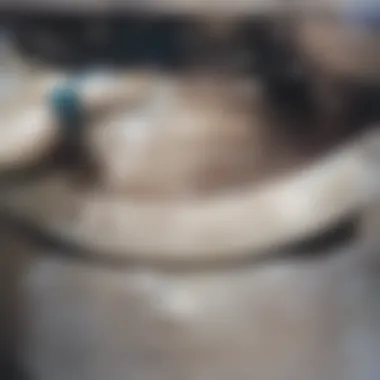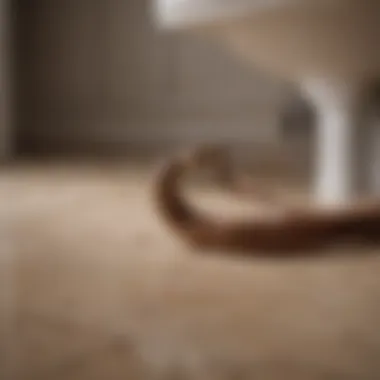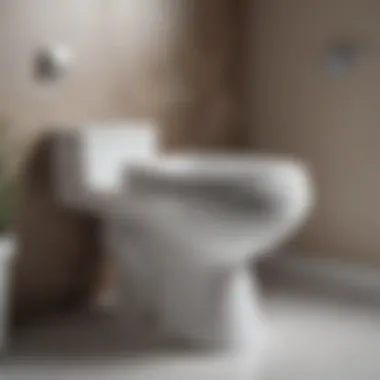Mastering the Plumbing Snake: A Complete Guide


Intro
Clogs in the toilet are a common issue many homeowners face. When this happens, it can be frustrating and inconvenient. Utilizing a plumbing snake is an effective way to address this problem. Understanding how to use a plumbing snake properly can help you resolve clogs without causing additional damage to your plumbing system. This guide aims to demystify the process and offers practical insights.
Understanding the Plumbing Snake
Before diving into the techniques for using a plumbing snake, let's first look at what a plumbing snake is. This tool, also known as a drain auger, is designed to navigate and clear blockages in pipes. Typically, it consists of a long, flexible metal wire that can reach deep into plumbing fixtures.
Types of Plumbing Snakes
There are various types of plumbing snakes, and knowing which one to use can make a difference:
- Manual snakes: These are often hand-cranked and ideal for smaller clogs.
- Electric snakes: More powerful, these are used for tougher blockages and larger pipes.
- Toilet augers: Specifically designed to clear clogs in toilets, this type has a distinct shape to maneuver through the toilet’s trap.
Tools and Materials Needed
When preparing to use a plumbing snake, it's crucial to have the right tools. Here’s a simple list:
- Plumbing snake: Choose the appropriate type for your needs.
- Gloves: Protect your hands from germs and debris.
- Bucket: To catch excess water that may spill from the toilet.
- Rags: Useful for cleaning up afterward.
Techniques for Using a Plumbing Snake
Using a plumbing snake correctly involves several steps:
- Preparation: First, put on your gloves and remove any visible debris from the toilet bowl.
- Insert the Snake: Carefully insert the snake into the toilet bowl until you reach resistance. It is essential to avoid forcing it too hard to prevent damage.
- Crank the Handle: If you are using a manual snake, begin turning the handle slowly. Allow the snake to move deeper into the plumbing while gently pushing forward.
- Dislodge the Clog: Once you feel the snake catch onto the clog, continue cranking to break it up. You may need to move the snake back and forth to fully clear it.
- Pull it Out: After dislodging the blockage, slowly retract the snake from the toilet. Be prepared for any debris or water.
- Flush: After removal, flush the toilet to ensure that water flows freely.
Safety Considerations
Safety is paramount during this process. Always ensure your workspace is clean and that you have all necessary tools within reach. If the clog seems to be stubborn, it may be wise to consult a professional plumber, as incorrect use of a plumbing snake can lead to more significant plumbing issues.
"Proper technique and safety measures can save you time and ensure your toilet plumbing remains intact."
Utilizing a plumbing snake effectively requires knowledge and care. Through understanding how to operate this tool, you can maintain a functional toilet and feel confident when faced with clogs.
Understanding Toilet Clogs
Toilet clogs are a common issue in many households. They can disrupt daily routines and lead to bigger plumbing problems if not addressed timely. Understanding how toilet clogs occur is crucial for any homeowner. This knowledge not only helps in using tools effectively, like a plumbing snake, but also aids in preventing future clogs.
There are specific elements to consider when it comes to toilet clogs. Knowing the various causes can empower individuals to manage their toilets wisely. Moreover, recognizing the signs of a clog early can save time and resources. The following subsections will delve into the details of what typically leads to troublesome clogs, and the indicators that signal a blockage.
Common Causes of Toilet Clogs
Toilet clogs can arise from several factors. Often, it is the result of inappropriate items being flushed. Common culprits include:
- Excessive Toilet Paper: Using too much can lead to a blockage.
- Personal Hygiene Products: Items like tampons and wipes do not break down and can cause serious clogs.
- Foreign Objects: Toys or other non-flushable items can easily get stuck in the plumbing.
- Hard Water Buildup: Minerals can accumulate over time, restricting water flow.
Each of these causes can lead to varying degrees of blockage in the plumbing system. Understanding these factors can help prevent unnecessary clogs and save time.
Signs of a Clogged Toilet
Recognizing a clogged toilet in its early stages can ease the process of addressing the issue. Key signs to look for include:


- Slow Draining Water: Water that does not drain quickly may indicate a partial blockage.
- Gurgling Sounds: Air trapped in the plumbing can create odd sounds when flushing.
- Overflowing Toilet: A dramatic indication of a clog, where water spills over the rim.
If these signs are not addressed promptly, they often lead to further complications. Being aware of them allows homeowners to respond swiftly, potentially avoiding the use of a plumbing snake altogether.
Prologue to Plumbing Snakes
Plumbing snakes play a crucial role in addressing toilet clogs effectively. They are tools designed specifically to help clear blockages in plumbing systems, particularly in toilets, where clogs tend to be stubborn and require special handling. Understanding the function and types of plumbing snakes is essential for homeowners and DIY enthusiasts. By being knowledgeable about the variety of options available, individuals can choose the right tool for their specific needs, enhancing their ability to maintain a functional bathroom.
What is a Plumbing Snake?
A plumbing snake, also known as a drain snake or auger, is a flexible tool used to remove clogs from pipes. It consists of a long, coiled metal wire that can be inserted into a toilet or other plumbing fixtures. The snake works by breaking apart or grabbing onto the obstruction, allowing for a more efficient removal process. This tools serves as an alternative to chemical drain cleaners, which can often damage pipes or create hazardous situations. Utilizing a plumbing snake can save time and reduce the risk of plumbing issues getting worse.
Types of Plumbing Snakes
There are several types of plumbing snakes, each designed for different plumbing situations. Understanding these types will aid in selecting the best tool for unclogging tasks.
Handheld snakes
Handheld snakes are commonly used for smaller clogs and are ideal for home use. One key characteristic of a handheld snake is its manual operation, which allows for greater control over how the snake is used. This type is beneficial for those who want a straightforward, cost-effective solution. Handheld snakes often feature a sturdy handle and a flexible, coiled end, making them easy to maneuver. However, their limitation lies in their effectiveness against deeper or more severe clogs, where mechanical help may be necessary.
Motorized snakes
Motorized snakes are more powerful than handheld varieties and are used for tougher clogs. Their key characteristic is the motorized mechanism that automates the rotation and movement of the snake. This efficiency can make the unclogging process quicker and require less physical effort from the user. Motorized snakes are often regarded as a beneficial choice especially for professionals or individuals facing serious blockages in the plumbing system. However, they are generally more expensive and can be bulky, making them less practical for everyday home use.
Toilet augers
Toilet augers are specially designed for use in toilets, focusing on navigating the unique curves of toilet plumbing. A key characteristic of toilet augers is their longer, flexible cable that can effectively reach deep clogs without damaging the porcelain. This design makes them a preferred option for toilet clogs. They excel at clearing obstructions caused by waste, toilet paper, or foreign objects. However, toilet augers may not be suitable for larger plumbing systems and could be limited if the clog is beyond the toilet and deeper in the plumbing line.
In summary, understanding what a plumbing snake is and the different types available can empower homeowners. By selecting the appropriate snake for the task at hand, you increase the likelihood of effectively clearing your toilet clogs without professional help.
Preparing to Use a Snake
Using a plumbing snake effectively can save time and frustration when dealing with toilet clogs. However, successful unclogging requires adequate preparation. This section emphasizes the importance of not only gathering necessary tools but also understanding safety precautions before starting the job. Being prepared enhances confidence and helps avoid potential mishaps during the process.
Gathering Essential Tools
Plumbing snake
The plumbing snake serves as the primary tool for tackling a toilet clog. Its main function is to reach deep into the plumbing system to dislodge or break apart the blockage. Snakes come in various sizes and types, with the toilet auger being particularly designed for toilets. A key characteristic of a toilet auger is its flexible coil, which allows it to navigate bends in the toilet's trapway. Its design makes it a favorable choice for homeowners, as it is usually effective in clearing most common clogs.
Unique Features
One advantage of the plumbing snake is its straightforward use. Most models require only a bit of physical effort to operate. However, a possible disadvantage is that improper use can damage toilet fixtures or pipes. Thus, understanding how to operate it properly is essential.
Gloves
Gloves are another important tool. When using a plumbing snake, your hands will encounter unpleasant substances. The right gloves form a barrier between you and potential contaminants. This is particularly beneficial, as ensuring hygiene is crucial when dealing with plumbing issues like toilet clogs.
Unique Features
Using gloves enables you to maintain a higher level of cleanliness throughout the unclogging process. However, choosing gloves that enhance grip while still offering protection is necessary. Some gloves may not fit snugly, which can hinder your ability to manipulate the snake effectively.
Bucket


A bucket comes in handy as well. When using a plumbing snake, there may be spills or backflow issues. Having a bucket nearby ensures that you can easily manage any mess. It is a simple but often overlooked tool that can make the process smoother.
Unique Features
The bucket's capacity allows it to hold a significant amount of water and waste. A potential downside is that if it is too small, you might have to empty it frequently, adding to your overall workload. So, choosing an adequately sized bucket can prevent additional hassle.
Safety Precautions
Wearing protective gear
Wearing protective gear is essential during the unclogging process. This includes not only gloves but also eyewear or masks if necessary. Protective gear helps safeguard against any unexpected splashes or debris.
Unique Features
The significant advantage of wearing protective gear lies in minimizing health risks. Neglecting this important step could lead to exposure to harmful bacteria or chemicals, especially when dealing with sewer lines. Although some might find wearing protection uncomfortable, it greatly reduces potential hazards during the task.
Avoiding hazardous materials
Avoiding hazardous materials is crucial when preparing to unclog a toilet. Many common household chemicals can create dangerous reactions when mixed together. For instance, combining bleach with ammonia can produce toxic gases.
Unique Features
Being mindful of the substances around you protects not only your health but also the integrity of your plumbing system. If hazardous materials are present, it is often wise to use natural products or to refrain from plunging them into the drain altogether. The risk associated with hazardous materials makes it advisable to remain cautious and clear of these items until your task is complete.
Preparing to use a snake is as valuable as the unclogging process itself. Ensuring you have the right tools and safety measures in place can greatly enhance the efficiency of your efforts.
The Unclogging Process
The unclogging process is essential for every homeowner facing toilet clogs. Mastering it allows individuals to address plumbing issues effectively, saving both time and money on professionals. It involves understanding how to operate a plumbing snake correctly, ensuring safety throughout the task, and recognizing when the job is done. Effective unclogging skills can prevent minor inconveniences from becoming significant plumbing problems.
Positioning the Toilet Snake
Finding the toilet's drain opening
Finding the toilet's drain opening is a critical first step in the unclogging process. This aspect is essential because the position of the drain determines how effectively the plumbing snake can reach the obstruction. The main characteristic of this process is the need for accuracy; locating the drain opening precisely enhances the effectiveness of the entire procedure. This step is often popular for its simplicity and directness. A unique feature is the typical design of toilets, which usually places the drain near the center at the base. This characteristic allows for easier access with the snake but may vary slightly between models, thus some adaptation may be needed depending on the toilet type.
Inserting the snake correctly
Inserting the snake correctly is another vital element in the unclogging process. When done properly, this can significantly speed up the clearing of any obstruction. This characteristic is beneficial as a correct insertion allows the snake to follow the natural curves of the plumbing, encountering and breaking through clogs more effectively. The unique feature about this procedure is the gentle and steady pressure applied to the snake while inserting it, which minimizes the risk of damaging the plumbing. However, if not done with care, there can be disadvantages, such as forcing the snake at improper angles, leading to potential plumbing damage or failure to clear the clog effectively.
Techniques for Effective Snaking
Rotating the snake
Rotating the snake is a technique crucial for effective snaking. This method allows the user to use the snake's coil, enabling it to navigate around bends in the plumbing system. The key characteristic of this technique is its ability to enhance the snake's reach and ability to grip the clog. This makes it a favored method in unclogging since it maximizes the snake's effectiveness. A unique feature is the potential to feel resistance while rotating; this feedback indicates whether the snake is engaging with the obstruction or becoming stuck. However, rotation might not work with every clog, particularly if the blockage is too solid or extensive.
Pushing through the obstruction
Pushing through the obstruction is another technique that is essential in the unclogging process. This technique involves applying steady pressure to break or displace the clog, showcasing the snake’s designed flexibility. The characteristic of this method lies in its ability to dislodge materials effectively, providing a more direct approach than just rotation. The ease of pushing through the obstruction can be beneficial when dealing with softer blockages like paper. Nevertheless, care must be taken as excessive force could lead to damaging the plumbing or displacing materials further into the pipes, making the situation worse.
Recognizing When the Clog is Cleared
Recognizing when the clog is cleared is the final aspect of the unclogging process. This step involves observing changes in the toilet's behavior, such as water draining smoothly or returning to normal levels after flushing. A clear toilet signifies that the techniques used were effective. Possible signs of a cleared clog include the absence of gurgling sounds and clear water flow. Knowing when the clog is cleared is crucial to avoid unnecessary repeated attempts that could damage the plumbing. Paying attention to these signs will help maintain the integrity of the toilet and plumbing system.


Post-Snaking Procedures
After successfully using a plumbing snake, it is vital to follow certain post-snaking procedures. These steps ensure that the toilet functions correctly, minimize mess, and maintain hygiene. Properly handling these aspects not only enhances the efficiency of the unclogging process but also preserves the functionality of the plumbing system.
Flushing the Toilet
Flushing the toilet serves as the immediate first step after using the snake. This action removes any debris or remnants that the snake has dislodged. It's essential to flush multiple times if necessary. Each flush helps to clear the drain and verify that water flows smoothly without interruption. If water backs up or drains slowly, it could indicate that the clog was not entirely removed. In this case, returning to the snaking process may be required.
Cleaning Up After the Job
Cleaning up after unclogging is a critical part of the process. It includes both disposing of waste materials and cleaning the tools used.
Disposing of waste
Proper disposal of waste is crucial for maintaining sanitary conditions. Any contents that have been removed from the toilet must be sealed in a plastic bag and disposed of in the garbage. This measure prevents odors and contamination.
The key characteristic of waste disposal is its simplicity. It requires no special methods other than sealing and throwing away. This approach is beneficial as it reduces the risk of spreading germs or attracting pests. Notably, many homeowners appreciate this straightforward method, as it requires minimal effort.
The unique feature of proper waste disposal lies in its emphasis on hygiene. It ensures that bacteria do not linger, which could pose health risks. However, failing to dispose of waste appropriately can lead to unpleasant odors and unsightly messes in the bathroom. Therefore, it is imperative to handle this step with care to maintain cleanliness.
Cleaning tools
After using a plumbing snake, it is important to clean the tools utilized. This action helps extend the life of the tools and ensures they are safe to use for future plumbing issues. Cleaning the snake involves rinsing it thoroughly to remove any debris or waste.
The key characteristic of cleaning tools after use is prevention. By cleaning and sanitizing the snake, the chances of introducing bacteria into the plumbing system during future use are minimized. This makes it a beneficial practice for any homeowner or DIY enthusiast.
The unique feature of cleaning tools includes the systematic approach to nurturing and maintaining equipment. By ensuring tools are well cared for, they remain effective and ready for the next challenge. However, neglecting this step can result in decreased performance over time, as debris build-up could hinder the tool's functionality.
Avoiding Common Mistakes
When dealing with toilet clogs, avoiding common mistakes is essential to ensure effectiveness and prevent further complications. Many individuals underestimate the challenges posed by toilet clogs, leading them to make decisions that can potentially worsen the situation or even cause damage to their plumbing. Understanding the typical errors and how to avoid them not only promotes a more successful unclogging experience but also fosters a respectful approach to home maintenance.
Overusing the Snake
Overusing a plumbing snake is a frequent pitfall many homeowners encounter. While it is tempting to persistently push the snake in search of a solution, excessive force can lead to more harm than good. Here are key aspects to consider when it comes to the overuse of a snake:
- Potential Damage: Repeatedly inserting and twisting the snake can scratch or dent the toilet’s porcelain interior. This could lead to further issues, such as cracks or leaks.
- False Security: Achieving temporary relief from the clog might create a false sense of system functionality. Continuous overuse does not address the root of the problem and could lead to recurring issues.
- Wear and Tear on Tools: Using the snake excessively can lead to wear and even breakage of the tool, potentially resulting in an unforeseen spending on replacements.
To avoid these outcomes, it's crucial to monitor resistance when using the snake. If you encounter significant obstruction, it may be wise to stop and reassess the situation.
Neglecting Professional Help
Another common mistake is choosing to handle a clogged toilet entirely on one's own without considering the value of professional assistance. Many people believe that all plumbing issues can be tackled independently, but some situations may warrant expert intervention. Factors to weigh include:
- Severity of the Clog: If the clog persists despite multiple attempts with a snake, it may indicate a more serious blockage or an issue within the plumbing system that requires professional equipment.
- Potential for Damage: Homeowners may accidentally cause additional problems if they push too hard or improperly use plumbing tools. A licensed plumber has training and experience to mitigate this risk.
- Long-term Solutions: Professionals can often identify underlying issues that contribute to frequent clogs, offering solutions that might prevent recurrence. A comprehensive assessment can save time and expense in the long run.
In summary, it is crucial to recognize when to step back and allow an expert to evaluate the situation. Striking the right balance between DIY troubleshooting and seeking professional help can significantly improve the outcome when addressing toilet clogs.
Closure
The conclusion section in this article summarizes the insights gained from using a plumbing snake for toilet clogs. This topic is essential for homeowners and DIY enthusiasts, as it provides practical knowledge that contributes to maintaining an efficient plumbing system. Being able to address a clogged toilet using a snake can save time, reduce expenses on professional plumbing services, and alleviate frustration associated with common household issues.
Summary of Key Points
In reviewing the main points covered in this guide, it’s clear that:
- Understanding Clogs: Recognizing common causes of toilet clogs helps in prevention and timely action.
- Choosing the Right Snake: Each type of plumbing snake serves a specific purpose; it's vital to use the correct tool.
- Proper Technique: Familiarity with effective utilizations, like rotating and pushing the snake, ensures successful unclogging.
- Post-Snaking Care: Flushing and cleaning tools are critical after the job to maintain sanitary conditions.
- Avoiding Pitfalls: Awareness of common mistakes, such as overusing the tool or disregarding when to call a professional, protects the integrity of plumbing systems.
These points not only guide practical application but also affect long-term plumbing health.







